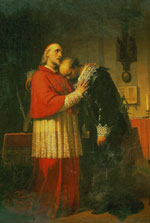|
 |
Home Page >
Textual pathway > The novel > I Promessi Sposi: plot (II)
 I Promessi Sposi: plot (II) I Promessi Sposi: plot (II)
 With the conversion of the Innominato, which ends the first,“negative” part of the plot, the story begins to move towards a favourable outcome. Lucia is released and finds hospitality in Milan at the home of two nobles, Donna Prassede and Don Ferrante. Cardinal Federigo summons Don Abbondio and rebukes him for not attending to his role as priest by refusing to celebrate the marriage of the young couple. The news of Lucia’s kidnapping and release reaches the village, and Don Rodrigo is forced to flee to Milan (Chapters XXIII-XXVI). At this point, historical events take over, and decisively so for the two protagonists: the war of the Mantuan succession; the famine; the plague - brought by the mercenaries who descended from Germany to help the Spanish, it spread rapidly also as a result of the erroneous measures taken by the civic and religious authorities (Chapters XXVIII-XXXII). Almost as a sign of Providence, it is the plague that brings the story to an end, by removing the cause of the young couple’s misfortunes, namely, Don Rodrigo, who falls ill and is taken to the Lazzaretto (where plague-sufferers were taken). At the Lazzaretto, the paths of the protagonists and some of the major characters cross. After recovering from the plague, Renzo returns to the village, where he sees Don Abbondio and Agnese, and then goes to Milan, where he experiences further adventures (he is mistaken for an untore, a plague-spreader) and witnesses highly moving scenes involving Cecilia’s mother. At the Lazzaretto he finds Lucia, who has also recovered from the plague, and at the Lazzaretto the young couple also come across Father Cristoforo, who charitably takes Renzo to forgive the dying Don Rodrigo, and annuls Lucia’s vow (Chapter XXXIII-XXXVI). The marriage between the two young people finally takes place; Renzo sets up a silkweaving business, and a large number of children are born: a “happy ending” (or so it seems) recounted by the author with considerable irony in the two final chapters of the novel (not included in Fermo e Lucia). With the conversion of the Innominato, which ends the first,“negative” part of the plot, the story begins to move towards a favourable outcome. Lucia is released and finds hospitality in Milan at the home of two nobles, Donna Prassede and Don Ferrante. Cardinal Federigo summons Don Abbondio and rebukes him for not attending to his role as priest by refusing to celebrate the marriage of the young couple. The news of Lucia’s kidnapping and release reaches the village, and Don Rodrigo is forced to flee to Milan (Chapters XXIII-XXVI). At this point, historical events take over, and decisively so for the two protagonists: the war of the Mantuan succession; the famine; the plague - brought by the mercenaries who descended from Germany to help the Spanish, it spread rapidly also as a result of the erroneous measures taken by the civic and religious authorities (Chapters XXVIII-XXXII). Almost as a sign of Providence, it is the plague that brings the story to an end, by removing the cause of the young couple’s misfortunes, namely, Don Rodrigo, who falls ill and is taken to the Lazzaretto (where plague-sufferers were taken). At the Lazzaretto, the paths of the protagonists and some of the major characters cross. After recovering from the plague, Renzo returns to the village, where he sees Don Abbondio and Agnese, and then goes to Milan, where he experiences further adventures (he is mistaken for an untore, a plague-spreader) and witnesses highly moving scenes involving Cecilia’s mother. At the Lazzaretto he finds Lucia, who has also recovered from the plague, and at the Lazzaretto the young couple also come across Father Cristoforo, who charitably takes Renzo to forgive the dying Don Rodrigo, and annuls Lucia’s vow (Chapter XXXIII-XXXVI). The marriage between the two young people finally takes place; Renzo sets up a silkweaving business, and a large number of children are born: a “happy ending” (or so it seems) recounted by the author with considerable irony in the two final chapters of the novel (not included in Fermo e Lucia).
 
|
|
 |
 |
 |
 |
 |
 |
 |
 |
     |
